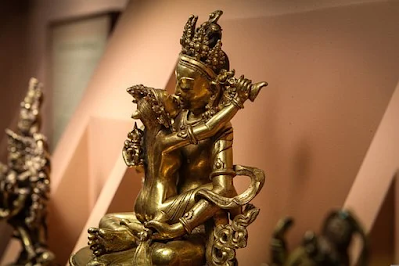A broad word for a
subset of religious activities that are centered on hidden rituals.
These are most often given forth in tantras
("loom") writings, which are so termed because they weave a separate
image of reality.
Tantric practitioners (tantrikas) are connected with illegal
sexuality, the use of prohibited foods such as meat and wine, and the capacity to
murder or injure others via black magic in popular Hindu culture.
Tantrikas are feared because of their might and alleged
amorality, a feature that some individuals have exploited.
Tantra's three traits, according to a more objective
appraisal, are secrecy, power, and nondualism, or the ultimate oneness of all
things.
In tantra, secrecy serves two purposes.
On the one hand, it keeps the rituals and practices hidden
from those who are ineligible to receive them, and on the other, it establishes
a religious subcommunity with a distinct identity and feeling of privilege.
One of the reasons tantra is seen as a higher religious
practice is the feeling of exclusivity that comes with knowing something that
only a few people know about.
Even though a tantra's text has been written down, it is considered
that the texts are lifeless until they have been instructed by a skilled
individual.
Because of this emphasis on personal transmission, diksha (a
sort of initiation) is the only method to obtain access to this system, and
tantra emphasizes the guru-disciple relationship even more than the Hindu
tradition as a whole.
Gurus have complete discretion over who they initiate.
Although many tantrikas are twice born men, that is, members
of the three highest classes (varnas)—brahmins, kshatriyas, and vaishyas—who
have received the adolescent religious initiation known as the second birth,
tantric practice is theoretically open to everyone, regardless of gender or
social status.
Tantra's power manifests in a variety of ways.
One of them occurs during the transmission of the
instruction itself, when it is thought that the guru's empowerment is required
to "activate" the taught information, especially mantras.
Tantric practice is also said to be significantly more potent
than traditional religious practice, and so more effective in achieving
ultimate soul freedom (moksha).
The common argument is that tantra's power allows for such
emancipation in a single lifetime, while other types of religious practice
require eons.
The emphasis on secrecy stems from the fact that such
tremendous powers must be kept hidden from the uninformed.
It is commonly acknowledged that as a natural outcome of
spiritual achievement obtained via tantric practice, superhuman abilities
(siddhi) are attained.
Although aspirants are discouraged from pursuing such
abilities since the act of seeking is considered as founded in selfish desire,
individuals who get them without seeking are said to be able to employ them
without becoming corrupted.
Nondualism—the belief that all reality is ultimately one
thing—is both a philosophical affirmation and a guiding concept for tantrikas
in their religious practice.
Tantrikas commonly regard their chosen god (ishtadevata) as
the material, efficient, and ultimate cause of all reality.
For tantrikas, finally seeing the basic oneness of all
things frees them from the erroneous understanding that leads them to be bound
and reborn.
Tantric practice upholds nondualism, with ceremonies
emphasizing the merging of opposing locations.
As a result, some tantrikas perform rituals with items that
are not explicitly banned, such as the "Five Forbidden Things"
(panchamakara): fish, alcohol, meat, parched grain, and sexual intercourse.
In principle, this ritual is a way to break down dualism
since it defies society conventions prohibiting intoxication, nonvegetarian
cuisine, and illegal intercourse, in an attempt to sacralize what is generally
banned.
Although this ceremony blurs the lines between good and
evil, pure and impure, the purpose is to replace exterior rites (bahiryaga)
with internal rites (antaryaga), thereby exploding the subject-object
dichotomy.
Tantric yoga is the model for this kind of inner work.
This is generally a kind of kundalini yoga in which the two
divine elements of Shiva and Shakti are brought together in the subtle body of
the practitioner.
The last vehicle for tantric practice is rituals using
symbolic diagrams (yantra), of which the shrichakra is an example.
These are generally peculiar to tantric lineages
(parampara), grounding the aspirant in a certain tradition.
See Arthur Avalon's (Sir John Woodroffe's) Shakti and
Shakta, 1978; Swami Agehananda Bharati's The Tantric Tradition, 1977; and
Douglas Renfrew Brooks' The Secret of the Three Cities, 1990 for further
details.
You may also want to read more about Hinduism here.
Be sure to check out my writings on religion here.

